| 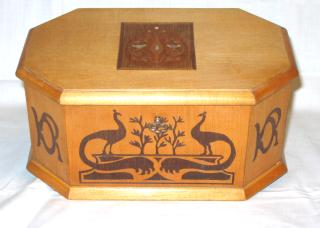
|
Jugendstil Marquetry Box.
Wonderful and unusual Jugendstil Box. Germany, 1890-1900.
The eight-sided shape is giving this box a very special and
uncommon appearance.
It is made of that we think is aspen wood with mahogany, rosewood
and mother of pearl inlaid on the outside and a surprising interior
with the sides veneered with bird’s-eye maple. Considering
its normally bright colour, here it is may be dyed.
On the top it has a wonderful marquetry work depicting a symmetric
scene with two birds on a tree branch. The birds and the tree’s
flowers are made of mother of pear inlaid.
Caja Jugendstil de Marquetería.
Maravillosa e inusual caja Jugendstil. Alemania, 1890-1900.
La forma octogonal le da a esta caja un aspecto muy especial
y poco común.
Está realizada en lo que nosotros creemos que es madera
de álamo con incrustaciones de palisandro, caoba y nácar
para el exterior y un sorprendente interior chapado con arce
de ojo de perdiz. Puede que éste esté teñido,
dado su intenso color.
En la tapa tiene un maravilloso trabajo de marquetería
mostrando una escena simétrica con dos pájaros
sobre una rama de árbol. Los pájaros y las flores
son de incrustaciones de nácar.
Sold / Vendida
|
| |
|
| 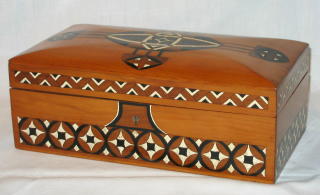
|
Jugendstil Secessionist box.
Very interesting Jugendstil (Art Nouveau) box
in the secession style. Austria or Germany around 1900.
It is made of cherry-tree wood and richly enameled with a typical
secession patern.
Caja Jugendstil Secesionista.
Muy interesante caja Jugendstil (Art Nouveau)
en estilo secesionista. Austria o Alemania hacia 1900.
Está realizada en madera de cerezo con una rica decoración
en esmaltes con un diseño típicamente secesionista.
|
| |
|
| 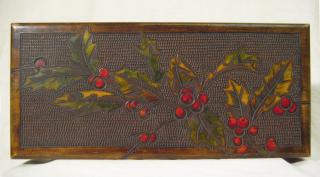
|
Holly Tree Box.
This will be "the ultimate" in your
Christmas decoration.
Here we have a quite big box from Germany around 1910-20.
It is made of linden wood, dyed, carved and enamelled with a
delicious Christmas design.
It is composed by holly tree branches with their leaves and
red fruits. The carving is very well detailed and the enamel
colours very realistic and blended.
Caja con decoración de Acebo.
Este será el "detalle final"
en su decoración navideña.
Una caja bastante grande de entre 1910 y 1920 de Alemania.
Está realizada en madera de tilo, teñida, tallada
y esmaltada con un delicioso diseño navideño.
Está compuesto de ramas de acebo con sus hojas y frutos
rojos. La talla es muy detallada y el esmaltado de colores muy
reales y armónicos.
|
| |
|
| 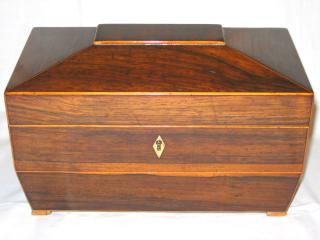
|
Regency Tea Caddy.
A Regency shaped rosewood tea caddy with pyramided
top and string inlay with boxwood. England, around 1830.
It is veneered in particularly well-figured rosewood and it
has the original escutcheon made of bone.
Caja de Te Regency.
Caja de te Regency de palisandro con tapa piramidal
y bordeada de madera de boj. Inglaterra, hacia 1830.
Está chapada en un palosanto con un veteado especialmente
interesante y tiene su bocallave original de hueso.
Sold / Vendida
|
| |
|
| 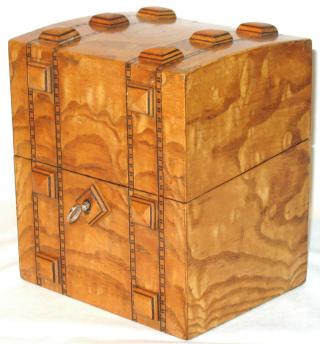
|
English Tea Caddy.
A tea caddy with slightly domed top and marquetry
inlay. England, around 1800-1820.
It is veneered in an interesting burled elm and it has the original
escutcheon made of the same wood.
The interior is fitted with the original red velvet.
The glass bottle, original too, it’s closed nearly hermetically
with the stopper.
Caja de Te Inglesa.
Caja de te con tapa ligeramente abombada y con
aplicaciones de marquetería. Inglaterra, hacia 1800-1820.
Está chapada en una interesante raíz de olmo y
tiene su bocallave original de la misma madera.
El interior está revestido de terciopelo rojo original.
La botella de cristal también es original y está
cerrada de un modo casi hermético por su tapón.
|
| |
|
| 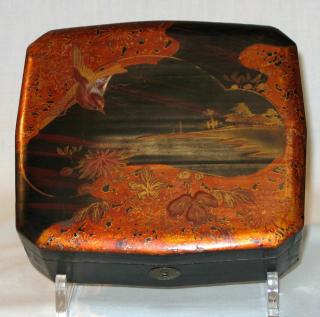
|
Japanese Lacquer Box
Lacquer Japanese box. Japan around 1900.
Produced for exporting to occident.
The top shows a typical oriental landscape with a river and
an small village, all surrounded by vegetal decorations and
a bird.
Caja lacada japonesa.
Caja lacada japonesa. Japón hacia 1900.
Producida para exportación a occidente.
La tapa muestra un paisaje oriental típico con un río
y un pequeño pueblo, todo ello rodeado de decoraciones
vegetales y un ave.
|
| |
|
| 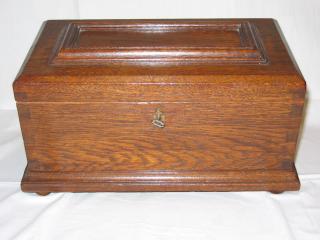
|
Jugendstil Oak Box.
This is a very nice Jugendstil box made of massive Oak. It
is German from around 1900.
The box is constructed with solid and visible dovetail joints
in the four corners.
The top shows a moulding decoration that is repeated around
the lower part of the body.
Caja Joyero Jugendstil de Roble.
Esta es una bonita caja Jugendstil de roble. Es alemana de
hacia 1900.
Su construcción es con juntas de cola de milano visibles
en las cuatro esquinas.
La tapa muestra una decoración con una moldura que aparece
también alrededor de la parte inferior del cuerpo.
|
| |
|
| 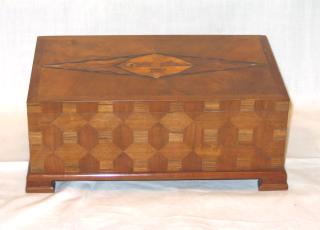
|
Art Deco Marquetry Box.
More pictures avalaible at the details page.
Description coming soon.
Caja art Deco de Marqueteria.
Mas fotos disponibles en la página de
detalles.
Descripción en unos días.
|
| |
|
| 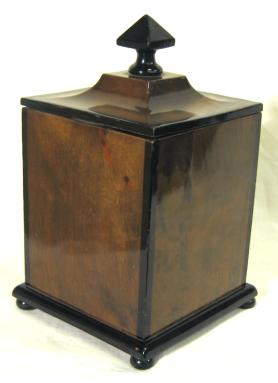
|
Art deco Tobacco-box (Germany, around 1920).
This Art Deco tobacco-box surprises in a first look with its
Biedermeier appearance. This can be explained by the fact that
the Biedermeier-style with its clear and clean forms inspired
the Art Deco-design.
Caja para tabaco Art deco (Alemania, hacia 1920).
Esta caja para tabaco Art Deco, sorprende a primera vista por
su aspecto Biedermeier. Esto se explica por el hecho de que
el estilo Biedermeier con sus formas claras y limpias inspiró
el diseño del Art Deco.
|
| |
|
| 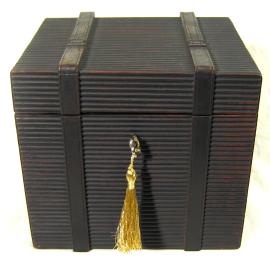
|
Late Biedermeier box.
Lets call it a black pearl that unveils its beauty
not on the first view. It follows the appearance of a suitcase
of these times in the way of wicker baskets and closed by two
leather straps with belt buckles on the top. These are carved
carefully and well detailed.
The age of this box is difficult to estimate. By looking at
the locksmiths work it could have been made somewhere around
1850-60.
Caja Biedermeier tardío.
Démosle el nombre de perla negra que no
desvela su belleza al primer vistazo. Tiene la apariencia de
una maleta de mimbre de esos tiempos cerrada por dos cinchas
de cuero con sus hebillas en la tapa. Estas partes están
talladas de un modo muy cuidadoso y bien detallado.
La edad de esta caja es difícil de estimar. Observando
el trabajo de cerrajería puede haber sido realizada alrededor
de 1850-60.
|
| |
|